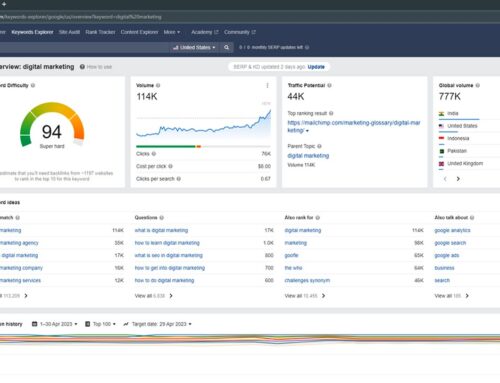Understanding the intricacies of your market is a prerequisite to business success. As a business owner, manager, or marketer, knowing how to conduct comprehensive market research is a crucial skill. This article will provide you with a detailed guide on the how-tos of effective market research. You’ll learn the key steps, methods, tools, and strategies you need to uncover insightful data, enabling you to make informed decisions.
Table of Contents
- Understanding Market Research
- Steps to Conducting Market Research
- Market Research Methods
- Tools for Market Research
- Making Sense of Your Findings
- Final Thoughts
- Key Takeaways Table
- Sources
Understanding Market Research
Market research is a critical tool in the arsenal of businesses and marketers, a systematic and organized effort to gather and analyze information regarding markets, competitors, and consumers. It dives deep into the industry landscape, demographics, psychographics, consumer behaviors, and buying habits. By offering a clear perspective on consumer needs, market trends, and competitive positions, market research plays a pivotal role in formulating business strategies.
The goal of market research is to provide an evidence-based understanding that aids in decision making, reduces uncertainty, and provides businesses with a competitive edge. By exploring market dynamics, businesses can identify potential opportunities, understand the impacts of macro and microeconomic factors, and stay ahead of industry trends.
Moreover, market research isn’t a one-time activity. It is a continuous process, aligning with the ever-evolving market scenarios and consumer behaviors. As markets transform and consumer needs evolve, businesses that regularly engage in market research will have their finger on the pulse, ready to adapt and respond effectively.
In a nutshell, understanding market research means understanding your industry, your competition, and your customers. It equips businesses with valuable insights, helps minimize risks, and drives informed decision-making, ultimately steering organizations towards growth and success.
Steps to Conducting Market Research
Conducting market research is a meticulous and methodical process, requiring planning and strategy. The following steps can guide you in this critical endeavor:
1. Define Your Research Objectives
Start by outlining what you intend to discover through your market research. This stage is crucial as it sets the direction for your entire research process. Objectives could include understanding customer needs and behavior, identifying key market trends, evaluating your competition, or assessing market growth and opportunities. Defining clear and concise objectives helps to ensure your research stays focused and relevant.
2. Identify Your Target Audience
The next step involves identifying who your research will focus on—your target audience. It’s important to segment your market and define specific groups of customers based on relevant characteristics. These can include demographic factors like age, gender, and income level, or psychographic factors like lifestyle and buying behavior. A well-defined target audience allows for more accurate and relevant data collection.
3. Choose Your Research Method
The research method you choose largely depends on your objectives, resources, and budget. Quantitative methods like surveys and experiments are great for collecting statistical data, while qualitative methods like focus groups and interviews provide deeper insights into consumer attitudes and behaviors. Secondary research, involving the analysis of existing data, can also provide valuable market insights.
4. Collect Data
Once you’ve chosen your research method, you can begin to collect data. It’s important to ensure your data collection methods are unbiased and representative of your target audience. Consider using a mix of methods to gather a comprehensive array of data.
5. Analyze and Interpret the Data
After you’ve collected your data, it’s time to analyze and interpret it. This step involves sifting through your data to identify patterns, trends, and insights. Analyzing your data helps you draw meaningful conclusions that can guide your business decisions.
Remember, the way you execute each step can have a significant impact on the quality of your research findings. Effective market research isn’t just about collecting data—it’s about collecting the right data, and then accurately interpreting it to inform your business strategy.
Market Research Methods
Market research methods are the techniques and strategies used to gather and analyze data. Choosing the right method can significantly impact the validity and reliability of your research findings. Here’s a more detailed look at some common market research methods:
1. Surveys
Surveys are a versatile and widely used method for quantitative research. They are ideal for gathering large volumes of data that can be easily analyzed statistically. Surveys can be conducted through various mediums such as online, over the phone, via mail, or in-person. They’re especially useful when you want to understand trends or gather demographic information.
2. Focus Groups
A focus group involves a guided discussion with a small group of individuals, typically 6-10 people. This method is qualitative and allows researchers to dive deep into specific topics. Focus groups can provide valuable insights into customer attitudes, perceptions, and beliefs, which can be difficult to capture through quantitative methods. They are often used to gather more nuanced information about consumer experiences and preferences.
3. Interviews
Similar to focus groups, interviews offer qualitative insights but on a more personal level. They can be conducted face-to-face, over the phone, or through digital platforms. Interviews provide a wealth of detailed information and allow you to probe deeper into the respondent’s thoughts and feelings. They can be structured with a predetermined set of questions or unstructured, allowing the conversation to flow more naturally.
4. Observation
Observational research involves directly observing and recording behaviors and interactions. This method can offer valuable insights into how consumers interact with products, services, or environments. Observation can be done in a naturalistic setting (e.g., observing customer behavior in a store) or in a controlled environment (e.g., usability testing).
5. Secondary Research
Secondary research involves analyzing existing data. This could include academic journals, government publications, industry reports, or company records. Secondary research can provide a broader context for your study and help identify trends, opportunities, or challenges in the market. However, it’s essential to ensure that the data is reliable, up-to-date, and relevant to your research objectives.
Selecting the right method(s) will depend on your research objectives, resources, timeline, and the nature of the information you are seeking. A combination of methods often provides the most comprehensive view of the market.
Tools for Market Research
The process of conducting market research has been greatly facilitated by numerous tools and platforms designed to help businesses gather, analyze, and interpret data. Let’s take a closer look at some of these tools:
1. Survey Tools
Online survey platforms like SurveyMonkey, Typeform, and Google Forms can streamline the process of collecting quantitative data. These tools provide customizable survey templates, question types, and design features. They also offer features for audience targeting and data analysis, making it easier for researchers to draw meaningful conclusions.
2. Social Listening Tools
Social listening tools such as Hootsuite, Brandwatch, and Sprout Social allow you to monitor social media platforms for mentions of your brand, competitors, or relevant keywords. These tools help capture the voice of the customer, track sentiment, and identify trends in real-time, providing valuable insights into consumer behavior and perceptions.
3. Analytics Tools
Google Analytics, SEMRush, and SimilarWeb offer comprehensive insights into website performance, traffic sources, user behavior, and more. They’re invaluable for tracking online customer behavior, understanding how customers interact with your digital platforms, and optimizing your digital marketing efforts.
4. Customer Relationship Management (CRM) Tools
CRM platforms like Salesforce, HubSpot, and Zoho offer an extensive suite of tools to manage and analyze customer interactions and data. They can help businesses understand customer behaviors, patterns, and preferences, facilitating more effective marketing, sales, and customer service strategies.
5. Market Research Platforms
Nielsen, Ipsos, and Statista are examples of market research companies that provide access to a vast array of market data and insights, including consumer surveys, industry reports, and market statistics. These platforms can significantly enhance your secondary research capabilities.
6. Data Visualization Tools
Tools like Tableau, Microsoft Power BI, and Google Data Studio can transform complex datasets into visual, easy-to-understand reports and dashboards. These tools are crucial for interpreting and presenting your research findings in a way that’s accessible and meaningful.
Remember, the right combination of tools will depend on your specific research objectives, resources, and capabilities. Regardless of the tools you choose, ensuring accurate and ethical data collection and analysis is paramount to conducting effective market research.
Making Sense of Your Findings
Making sense of your findings is arguably the most crucial step in the market research process. The data you’ve collected, regardless of volume, has little value unless it’s analyzed and interpreted to yield actionable insights. Here’s a detailed look at how you can transform your raw data into valuable knowledge:
1. Data Cleaning and Preparation
The first step involves cleaning and preparing your data for analysis. This means checking for and addressing errors, inconsistencies, or outliers in the dataset. If you’ve collected data through surveys, this might involve removing incomplete responses or coding open-ended responses.
2. Data Analysis
Next, you’ll want to analyze your data to identify patterns, trends, and correlations. The type of analysis you conduct will depend on your research objectives and the nature of your data. For quantitative data, this might involve statistical analysis, while qualitative data might require thematic analysis or content analysis.
3. Interpretation
Interpreting your data involves making sense of your analysis results within the context of your research objectives. This step often involves drawing conclusions about what the data means for your business. For example, if your research was focused on customer needs, you might interpret trends in your data as indicating preferences for certain product features or price points.
4. Presentation
Presenting your findings involves summarizing and communicating your results in a clear and accessible way. This could involve creating reports or dashboards that highlight key findings, trends, and insights. Visual representations of data, like charts and graphs, can be particularly effective in conveying complex information.
5. Action
Finally, it’s crucial to use your research findings to inform decision-making and action within your organization. This might involve updating your business strategy, making changes to your products or services, or developing new marketing initiatives.
Remember, making sense of your findings isn’t just about understanding what the data is telling you—it’s about understanding what the data means for your business and how it can guide your actions. The ultimate goal is to turn the data-driven insights into strategies that drive business growth and success.
| Key Takeaways | Details |
|---|---|
| Defining Research Objectives | Begin your market research by outlining clear objectives to guide your research process. |
| Identifying Target Audience | Segment your market and define specific customer groups to collect relevant data. |
| Selecting Research Methods | Choose the method that best suits your objectives, resources, and budget. Surveys, focus groups, interviews, observations, and secondary research are all viable options. |
| Collecting Data | Employ chosen methods to gather data. Ensure your collection methods are unbiased and representative of your target audience. |
| Analyzing and Interpreting Data | Post-collection, sift through your data to identify trends, patterns, and insights. This forms the basis of your actionable business insights. |
| Using Market Research Tools | Leverage tools such as survey platforms, social listening tools, analytics tools, CRM platforms, and data visualization tools to facilitate your market research process. |
| Making Sense of Findings | The final step involves data cleaning, data analysis, interpretation, presentation, and taking action based on the research findings. |
Keep in mind that market research should be an ongoing process, consistently adapting to evolving market dynamics and consumer behaviors.
Final Thoughts
Market research is invaluable in navigating the business landscape. Not only does it minimize risk by offering evidence-based insights, but it also provides a solid foundation for your business strategy. The most critical takeaway is that market research should be seen as an ongoing process, not a one-time activity. Consistently tuning in to market dynamics ensures that your business remains relevant and competitive, maximizing your chances of success.











Leave A Comment